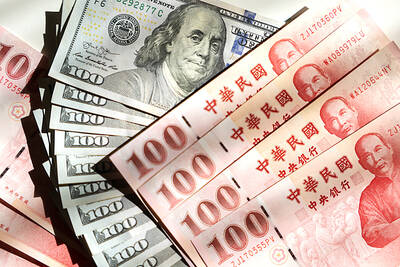The super-thin and light laptops promoted by Intel Corp, known as “Ultrabooks,” will remain a niche product in the near term but should gain more mainstream popularity next year, Bank of America Merrill Lynch said recently.
In a report on the Ultrabook market, Merrill Lynch forecast that global sales of Ultrabooks would total 15 million units this year and 50 million next year, accounting for 7 percent and 20 percent of total notebook sales in those years.
Asian PC brands such as Acer Inc (宏碁), Asustek Computer Inc (華碩), Samsung Electronics Co, Lenovo Group Ltd (聯想), Toshiba Corp and LG Electronics Co launched their first Ultrabooks in the fourth quarter of 2011, while Hewlett-Packard Co and Dell Inc introduced their first Ultrabook models last month.
“In the near term, price premium and lack of differentiation will halt the end-demand, but we expect more innovative Ultrabook form factors in the second half of this year, like touch screens, gesture control, voice recognition and NFC [near field communication],” Merrill Lynch wrote.
Ultrabook's pricing will need to be lowered to about US$750 to gain broader acceptance, and vendors may be able to move closer to the target this year by finding cost savings in the unit’s CPU, storage and casing, the US bank said.
Merrill Lynch said that Taiwan’s Acer and Asustek have been much more aggressive than global peers in promoting Ultrabooks.
Acer introduced its second Ultrabook model, the S5, at the Consumer Electronics Show (CES) in Las Vegas last month, and Asustek is targeting the launch of a model selling for around US$600 by the end of this year.
Merrill Lynch said some component makers may profit even more from Ultrabooks or slim form-factor notebooks than PC original design manufacturers.
“We expect subsectors like backlight, battery and hinge to be the biggest beneficiaries of the Ultrabook theme, while CPU socket, connectors, and thermal module makers might get hit on the back of the low-voltage requirement,” Merrill Lynch said.
Casing vendors may also face shrinking margins because PC vendors are still searching for lower-price solutions and materials to save costs, the US bank added.
In its report, Merrill Lynch maintained a positive outlook on LCD backlight module supplier Radiant Opto-Electronics Corp (瑞儀光電) and notebook battery pack maker Simplo Technology Co (新普科技), while remaining cautious on the prospects of Hon Hai Precision Industry Co (鴻海精密) and Foxconn Technology Co (鴻準).

MARKET LEADERSHIP: Investors are flocking to Nvidia, drawn by the company’s long-term fundamntals, dominant position in the AI sector, and pricing and margin power Two years after Nvidia Corp made history by becoming the first chipmaker to achieve a US$1 trillion market capitalization, an even more remarkable milestone is within its grasp: becoming the first company to reach US$4 trillion. After the emergence of China’s DeepSeek (深度求索) sent the stock plunging earlier this year and stoked concerns that outlays on artificial intelligence (AI) infrastructure were set to slow, Nvidia shares have rallied back to a record. The company’s biggest customers remain full steam ahead on spending, much of which is flowing to its computing systems. Microsoft Corp, Meta Platforms Inc, Amazon.com Inc and Alphabet Inc are

Luxury fashion powerhouse Prada SpA has acknowledged the ancient Indian roots of its new sandal design after the debut of the open-toe footwear sparked a furor among Indian artisans and politicians thousands of miles from the catwalk in Italy. Images from Prada’s fashion show in Milan last weekend showed models wearing leather sandals with a braided design that resembled handmade Kolhapuri slippers with designs dating back to the 12th century. A wave of criticism in the media and from lawmakers followed over the Italian brand’s lack of public acknowledgement of the Indian sandal design, which is named after a city in the

The US overtaking China as Taiwan’s top export destination could boost industrial development and wage growth, given the US is a high-income economy, an economist said yesterday. However, Taiwan still needs to diversify its export markets due to the unpredictability of US President Donald Trump’s administration, said Chiou Jiunn-rong (邱俊榮), an economics professor at National Central University. Taiwan’s exports soared to a record US$51.74 billion last month, driven by strong demand for artificial intelligence (AI) products and continued orders, with information and communication technology (ICT) and audio/video products leading all sectors. The US reclaimed its position as Taiwan’s top export market, accounting for

INVESTOR RESILIENCE? An analyst said that despite near-term pressures, foreign investors tend to view NT dollar strength as a positive signal for valuation multiples Morgan Stanley has flagged a potential 10 percent revenue decline for Taiwan’s tech hardware sector this year, as a sharp appreciation of the New Taiwan dollar begins to dent the earnings power of major exporters. In what appears to be the first such warning from a major foreign brokerage, the US investment bank said the currency’s strength — fueled by foreign capital inflows and expectations of US interest rate cuts — is compressing profit margins for manufacturers with heavy exposure to US dollar-denominated revenues. The local currency has surged about 10 percent against the greenback over the past quarter and yesterday breached